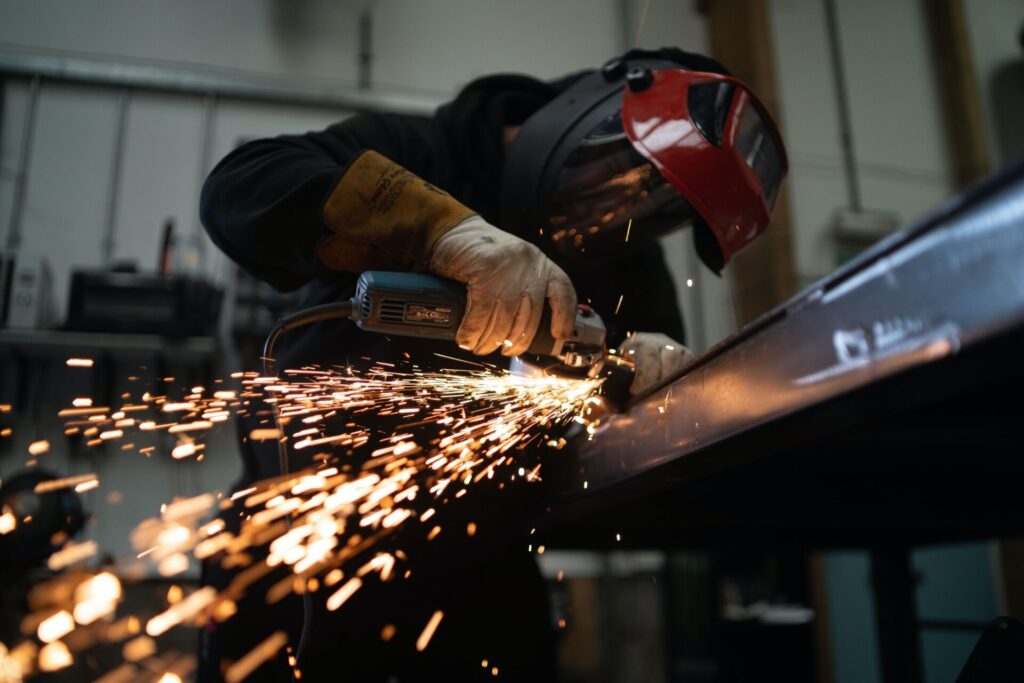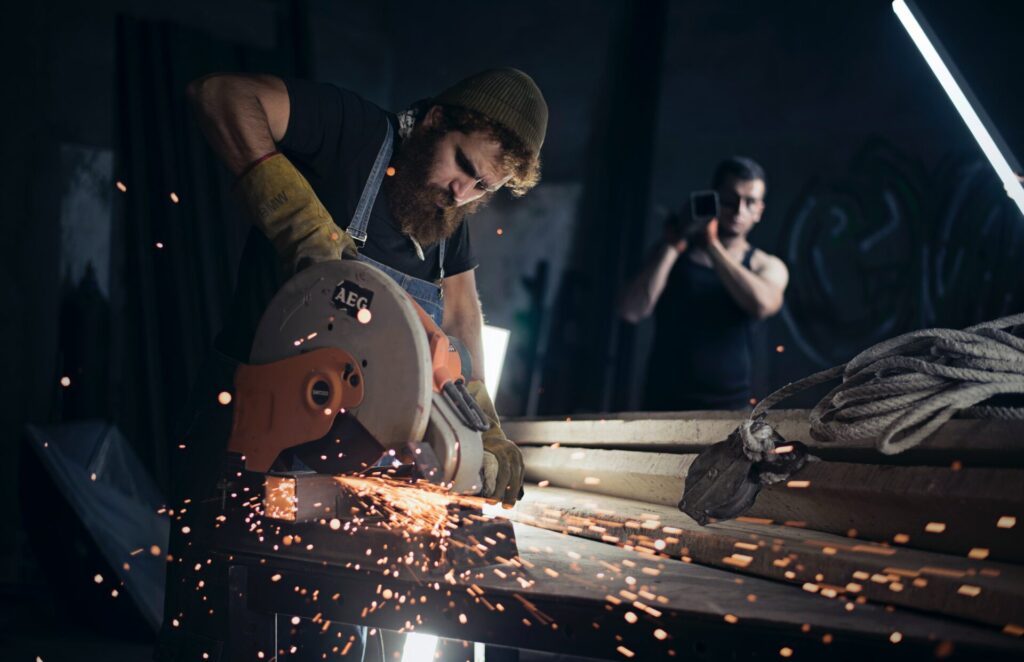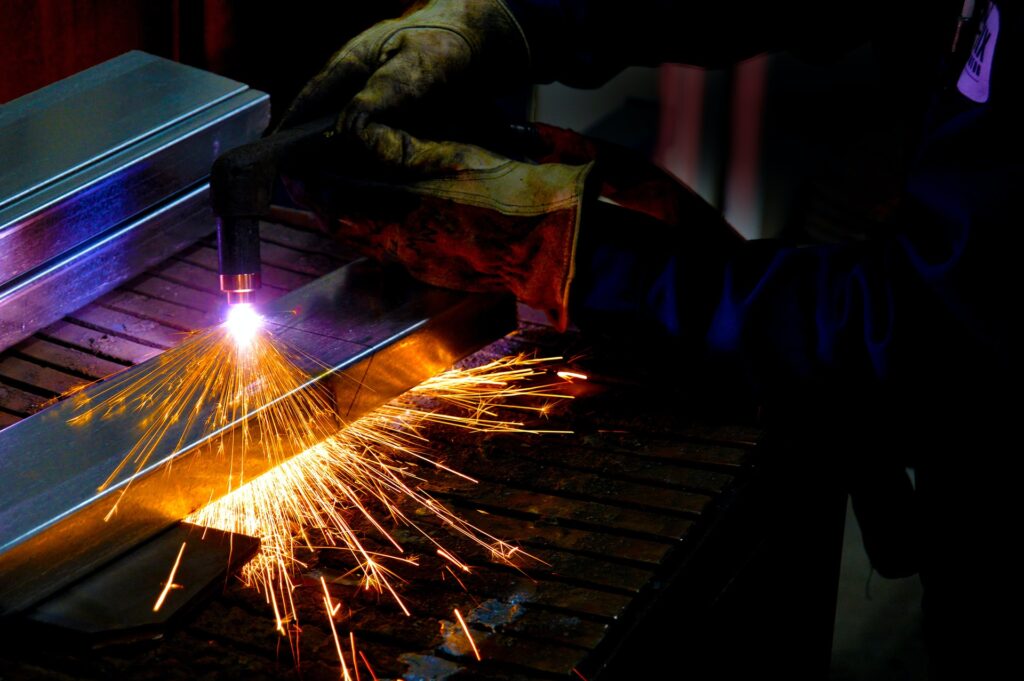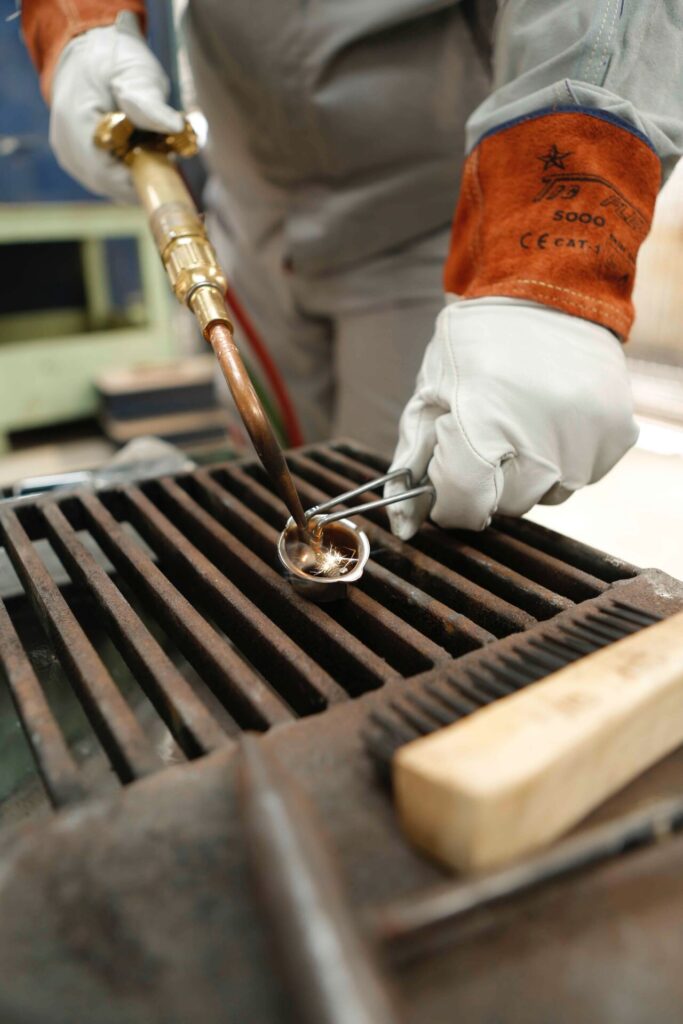Metal cutting tools play a huge role in metalworking. When starting out you may have to decide on one or two tools until funds allow you to expand your metal cutting arsenal.
We are going to break down 6 common metal cutting tools so you can make an informed decision. Each tool has pros and cons, and there is no one tool that can do it all well. When deciding which metal cutting tool is right for you, remember to keep your specific cutting situations in mind.
This page contains affiliate links in which we receive a small commission at no additional cost to you. As an Amazon Associate I earn from qualifying purchases.
Angle Grinder
When it comes to metal cutting tools, an angle grinder is the swiss army knife. Not only can you cut with it; you can grind, sand, and shape as well. As a plus, $40 or $50 can get you a more than adequate angle grinder.
An angle grinder is a tool that uses a motor to spin an abrasive disc at high RPMs in order to cut or prep metal. When used as a metal cutting tool, grinders are equipped with either a thin fiber cutting disc, or a metal cut off wheel with a hardened edge designed to cut metal.
Angle grinders are hand held tools. Because of this, you can cut just about any size or shape metal. It is also extremely portable, allowing you to take the grinder to your workpiece. This offers a lot of versatility and options when it comes to cutting.

Grinders are common in two sizes, a 4.5 inch and a 7 inch. The 4.5 inch is more common and least expensive. The 7 inch is larger and heavier, and should be reserved for cutting large or thick pieces of metal.
While angle grinders are a great tool, they don’t come without some drawbacks.
First, they create a lot of sparks. You need to be mindful of where the shower of sparks is directed to ensure you don’t damage anything in the immediate area. The shower of sparks can lead to fires, and can create a sandblasting effect on finished surfaces.
Fiber cut off discs are thin and somewhat brittle. It is important to make sure you are not side loading the cutting wheel and it is structurally sound. If the disc is damaged or side loaded it can break apart, sending pieces of the disc flying through the air at very high speeds. Wearing proper safety gear is a must. I personally have a grinding helmet that is similar to welding hood, covering my entire face.
Metal discs are safer in that they typically don’t come apart and send pieces flying everywhere. They tend to be more expensive than fiber discs, but they do last quite a while. The metal cutting wheels are loud, and if you don’t already wear ear protection (you should), it is definitely recommended when using a metal cut off wheel.
Angel grinders allow you to cut various shapes and angles, however cutting small, complex shapes or curves can be a real challenge. Since the cut off wheels don’t flex, and they disc is fairly large, you may have to rough cut your pieces. After they are rough cut, you can come back and and clean the up when you have more space and can get a different working angle.
If you can only afford one metal cutting tool, make it an angle grinder. It will allow you to prep, cut, and clean all with one tool. I actually own multiple grinders so I don’t have to change discs as often. I just pick up a different grinder.
Look for an angle grinder that is rated at 5 or more amps, the higher the better. The stronger motor will be less prone to over heating, and won’t be working at its maximum load all the time. If you are looking for a specific recommendation, The Metabo HPT grinder is a great mix of performance and value.
Band Saws
Portable Band Saw
Metal cutting band saws come in a couple of flavors. There are portable hand held band saws, and stationary, typically horizontal, band saws. Portable band saws can be corded or battery powered, making them even easier to transport.
When it comes to metal cutting tools, band saws are one of the cleaner options. There are no sparks, and metal dust and shavings stay in the immediate area of the saw. Band saws are also are a fairly quiet metal cutting option.
Portable band saws can be very affordable, some models start around $100. A portable band saw needs to be hand held when cutting, but it can be brought to your work. Due to the design of portable band saws, the depth of the cut is limited to around 5 inches in most models.
Even so, a portable band saw is great at cutting rod, tubing, and square stock. It can take a little bit of practice to get nice square cuts. The precision of the cut is mainly up to the users skill and technique. There are small tables and stands available to make a portable band saw into a vertical metal cutting saw. The Swag Off Road table is a great option that even allows the use of a miter gauge. A table like this will allow you to be more precise.
Horizontal Band Saw
Horizontal band saws are larger, stationary, metal cutting tools. The cut capacity is larger than a portable band saw and some models even have pumps built in to flood the cut with cutting fluid and keep things cool. Many have a switch below the cutting bed, so when the saw passes through the metal it automatically turns off. This combined with the weight of the saw allows for semi automatic cutting.
With the increase in size, power, and features, a horizontal band saw can come with a high price. Basic models start around $300 and go up to several thousand dollars. Rikon tools offers a quality option.
Some models offer the option of locking the saw vertically for more precise and complex cuts. This offers additional versatility for a piece or equipment that consumes a fair amount of floor space.
Its hard to beat a horizontal band saw if you work with a lot of tube, square, and round stock. Long pieces of material can be cut in a horizontal band saw. Due to the design of a band saw, it isn’t possible to cut large pieces of sheet or plate.
Chop Saws
Chop saws are one of the more specific types of metal cutting tools. They have either a metal or abrasive blade in a the same style as a miter saw, although with a larger blade. Most have an adjustable angle, and can cut through standard stock very quickly

Metal chop saws are typically benchtop saws, so make sure you have the space for one in your work area. These saws can be exceedingly loud, and ear protection is a requirement when using one. While they have a smaller foot print than a horizontal band saw, they can still make quick work of tubing and rod.
When putting one of these on a workbench, keep in mind that the abrasive blades will shower the entire area with sparks. The metal blades don’t produce any real amount of sparks, but the are just as loud as the abrasive blades.
It is not recommend to install a metal cutting blade on a standard woodworking miter saw. Their housing and shields are not meant to handle the hot sparks and metal dust that will be produced when cutting metal.
A chop saw will start around $175 and go up from there depending on the blade and other saw features. Be aware that a 14″ saw still only has 5″ of cutting capacity. It may be wise to go with a portable bandsaw unless you need to cut a lot of tubing quickly in a production setting.
Circular saw
If you have a circular saw, you may have started your collection of metal cutting tools without realizing it. Many manufacturers offer metal cutting circular saw blades that can install in any circular saw.
Like the metal chop saws above, a metal cutting blade in a circular saw won’t produce much in the way of sparks, but will be extremely loud when in use. Definitely wear ear protection when using one of these blades.
A circular saw will do a good job cutting standard round and square stock. In addition, you can cut long lengths of sheet metal and plate. This is something band saws and chop saws cannot do. The only things that a circular saw won’t be great at are curves and complex shapes.
If you have a circular saw already, a metal cutting blade only costs around $30. Even if you have other metal cutting tools at your disposal, it is worth picking up a metal cutting blade to have on hand. You never know when you might need to break down sheet goods into smaller pieces, and a circular saw can be the best tool for the job.
Plasma Cutter
Plasma cutters have become extremely affordable in recent years, making them one of the newest metal cutting tools available to the garage hobbyist. Starting at as little as $200 for a no touch pilot arc plasma cutter, there are tons of options out there.
Plasma Cutting is defined as follows:
The basic plasma cutting process involves creating an electrical channel of superheated, electrically ionized gas i.e. plasma from the plasma cutter itself, through the workpiece to be cut, thus forming a completed electric circuit back to the plasma cutter through a grounding clamp.
Plasma cutters can cut metal in any position, and in extremely tight areas. They can be extremely handy when making scrap metal art or working on vehicles. They are fairly quiet when it comes to metal cutting tools. Most of the noise is from the air leaving the torch. The only real issue are sparks. Believe it or not, plasma cutting produces the same amount of sparks as an abrasive chop saw or angle grinder, if not less.
Another plus to a plasma cutter is the lack of heat. Cutting with a plasma cutter produces a surprisingly low amount of heat through the metal you are cutting. The lack of heat also allows for the use of straight edges, compasses, and templates that can either be bought or made.
The major drawback to using a plasma cutter is the need for electricity and air. A plasma cutter requires a fairly large air compressor to operate. If you don’t already have one, you could easily spend as much, or more, on an air compressor as you do the plasma cutter itself.

Additionally, a plasma cutter requires a fair amount of electrical current. If you are welding or running any large shop equipment already, your current electrical system can probably handle the load. Be sure to check the power requirements before you make your purchase, and account for the air compressor running at the same time.
If you are thinking of adding a plasma cutter to your stable of metal cutting tools, I would strongly recommend getting a no touch pilot arc model. This means the torch does not need to touch metal to initiate a cut. Consumables will last longer, and you can cut painted or rusty metal with ease.
Torch
What list of metal cutting tools would be complete without the trusty torch? Oxy/Acetylene torches can cut through thick metal quickly and quietly. They do produces some sparks, and there is sure to be quite a bit of heat.
If you have to cut thick metal, a torch can be the best and fastest option. One major benefit of having a torch is the ability to heat metal and bend it. This is the only tool in our list that can cut metal, as well as soften it enough to bend easily.
Unfortunately, even though torches are fairly low tech, they can be quite expensive. In addition to the torch and hoses, you need two different gases (oxygen and acetylene) in two different cylinders. you will also need a way to regulate the gas coming out of the cylinders.
All of this can add up to a pretty substantial amount of cash. For around $175 you can get a cutting torch, hoses, and regulators. The price of gas and cylinders will vary depending on location and supplier. It is recommended to form a relationship with a local welding gas supplier for your gas needs.

Final Thoughts
Hopefully you have a better understanding of metal cutting tools. This is by no means an all inclusive list and not every tool will fit everyone’s budget and workflow. Over time you will discover what tools work well for you, and what you would like to add to your selection of metal cutting tools. My only real must have on this list is an angle grinder. There is so much you can accomplish with that one tool. As you progress and your budget allows, you can add other tools you deem necessary to the type of work you like to do.
